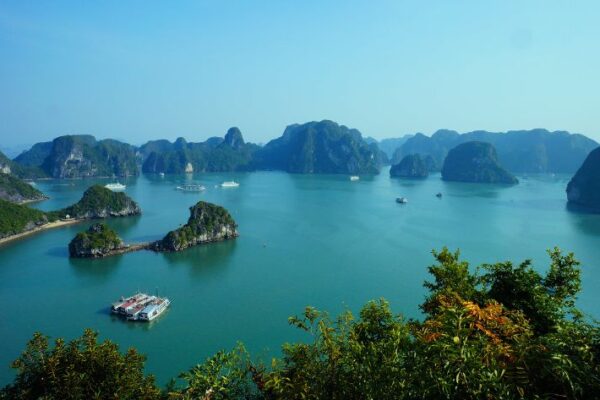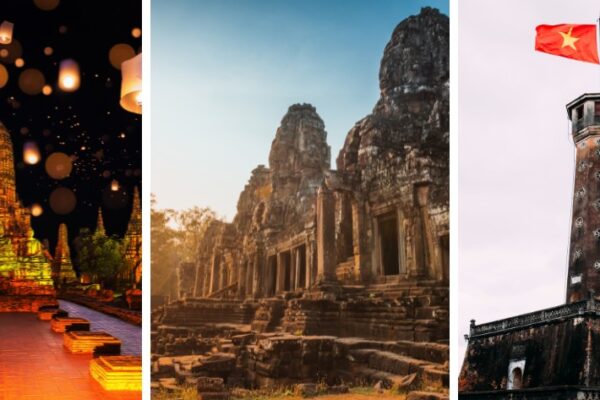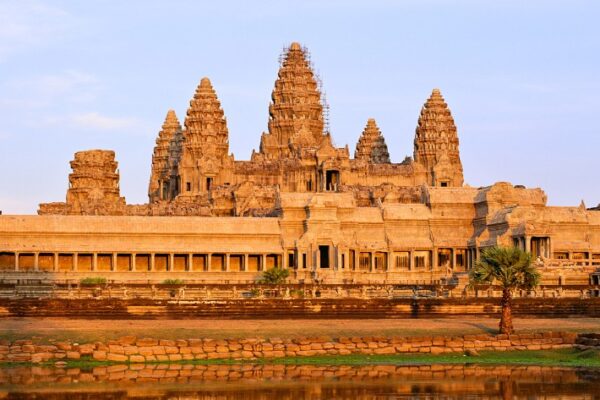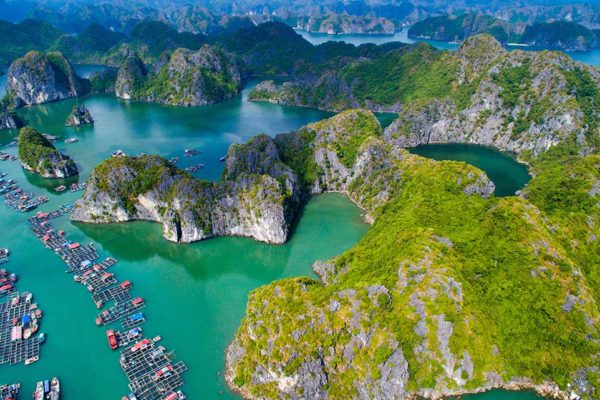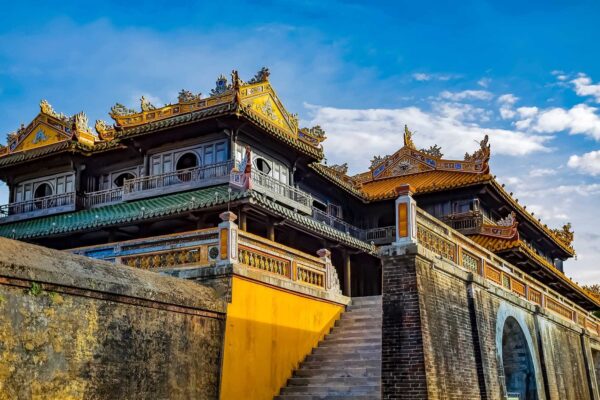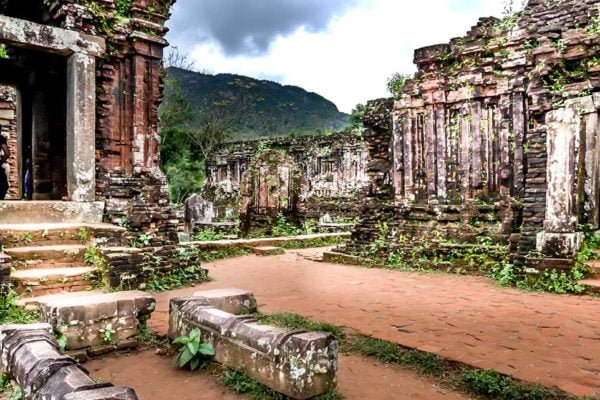What To Wear In Vietnam – A Comprehensive Packing Guide
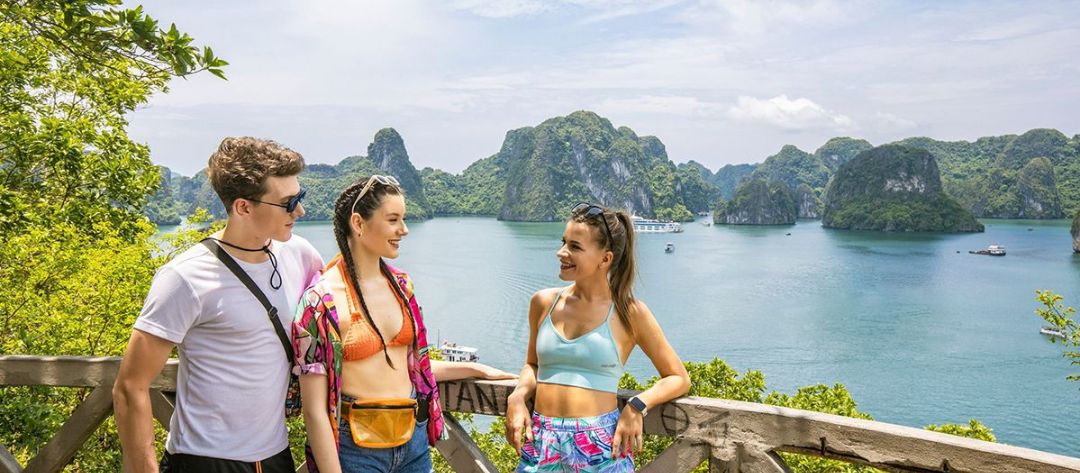
Vietnam is a welcoming country that invites you to immerse yourself in its rich culture and diverse landscapes. Nevertheless, dressing appropriately is not only a matter of climate but also of showing respect for local customs and practices. This guide will help you answer “What to wear in Vietnam?” with insights to navigate both the weather and cultural expectations, allowing you to fully embrace all that Vietnam has to offer.
Understanding Vietnam’s Climate & Regional Variations
Vietnam stretches over 1,000 miles from north to south, creating an astonishing variety of climates. This means your packing strategy must account for not only temperature differences but also rainfall patterns, humidity, and occasional extreme weather. Understanding these regional variations is the key to packing smart and staying comfortable throughout your trip.
Northern Vietnam (Hanoi, Sapa, Halong Bay)
The north experiences four distinct seasons, which is unusual for a tropical country. Winters (December to February) can be surprisingly cold, especially in mountainous areas like Sapa and Ha Giang, with temperatures dipping to 8–15°C, sometimes even below 5°C in higher altitudes. Summer (June to August), in contrast, is hot and humid, with daily highs reaching 32–35°C. Rain is frequent and heavy, often in the form of short, intense showers. Spring and autumn are generally mild but can be unpredictable, oscillating between cool mornings and warm afternoons.
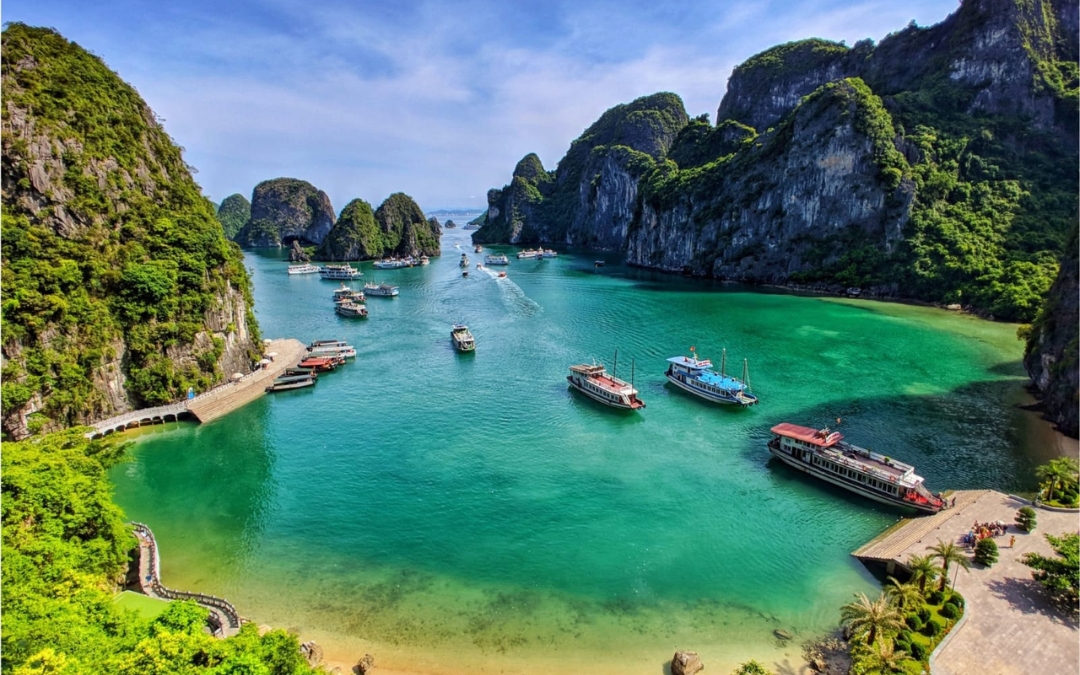
The north greets visitors with misty bays and cooler air.
>> Read More: Halong Bay Weather – A Comprehensive Guide for Every Season
Central Vietnam (Da Nang, Hoi An, Hue, Nha Trang)
Central Vietnam has a more extreme rainfall pattern. The dry season runs from January to August, while September to December brings heavy rains and the occasional typhoon, particularly in coastal cities like Da Nang and Hoi An. Temperatures remain relatively high year-round, usually 25–35°C, with high humidity. Winters are mild; summers are sweltering. Coastal areas are ideal for beachgoers during the dry months, but during the rainy season, travelers may face flooding and disruptions.
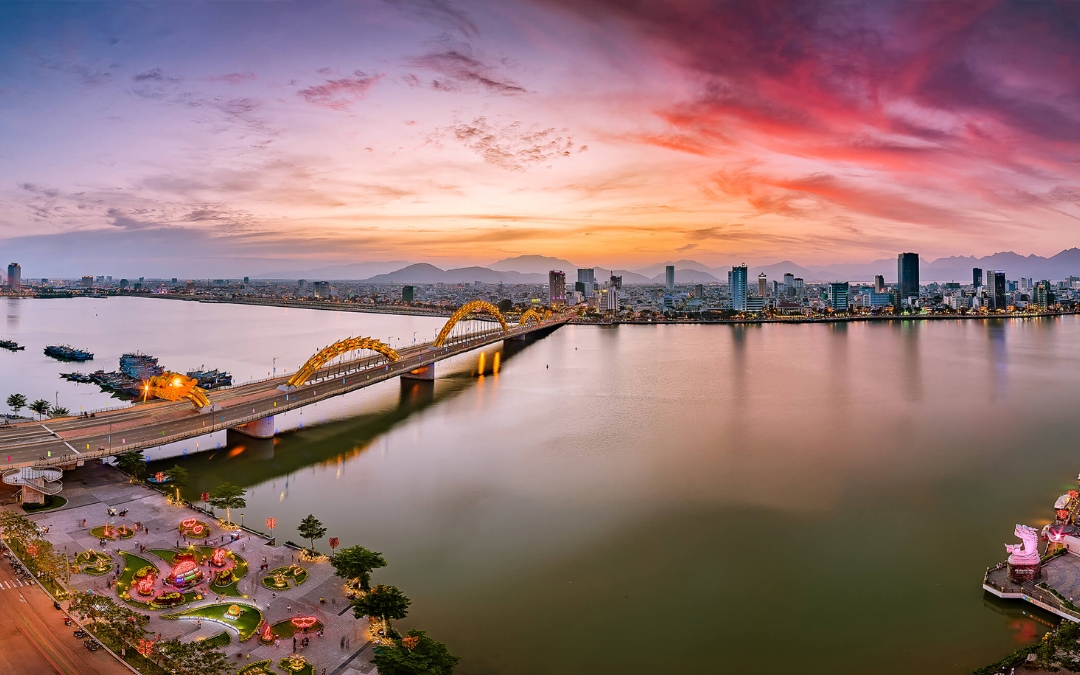
Central coasts bring sunshine mixed with sudden tropical rains.
Southern Vietnam (Ho Chi Minh City, Phu Quoc, Mekong Delta)
The south enjoys a tropical climate with only two main seasons: wet and dry. The dry season (December to April) is perfect for sightseeing and outdoor activities, with temperatures ranging from 28–35°C. The wet season (May to November) brings heavy afternoon showers almost daily, yet the rain is usually short-lived. Humidity stays high throughout the year, making breathable, lightweight clothing essential.
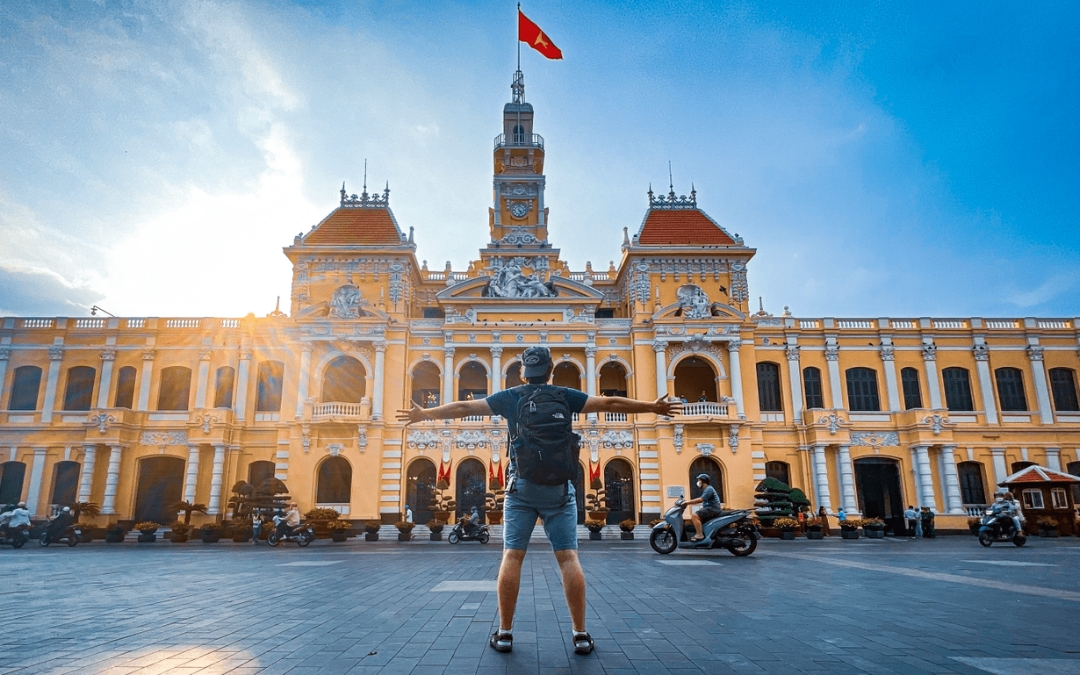
Saigon offers hot days with frequent afternoon downpours.
>> Read More: Phu Quoc Weather Guide – The Best Time to Visit for a Perfect Trip
Vietnam Packing List for First-Time Travelers: Clothing Essentials by Season
When packing for Vietnam, understanding what to wear in Vietnam each season can make the difference between an enjoyable trip and a frustrating one. From breathable fabrics in the south to versatile layers in the north, your clothing choices should match both the weather and your activities. Here’s a detailed breakdown for each season.
Spring (March – May)
The mild and comfortable Spring in most regions can make it one of the best times to travel. However, mornings and evenings can still be cool in the north, and occasional rains can appear anywhere.
What to pack for spring:
- Light layers: Long-sleeve shirts, thin sweaters, and light jackets.
- Bottoms: Comfortable jeans or chinos, and lightweight pants.
- Footwear: Breathable sneakers or casual shoes suitable for walking.
- Accessories: Sunglasses, hats, and a lightweight scarf for cooler mornings.
- Optional: A compact rain jacket or poncho for sudden showers.
Tips:
- Pack clothes that can be layered to adjust to changing temperatures throughout the day.
- Choose fabrics that dry quickly, especially if you encounter a spring shower.
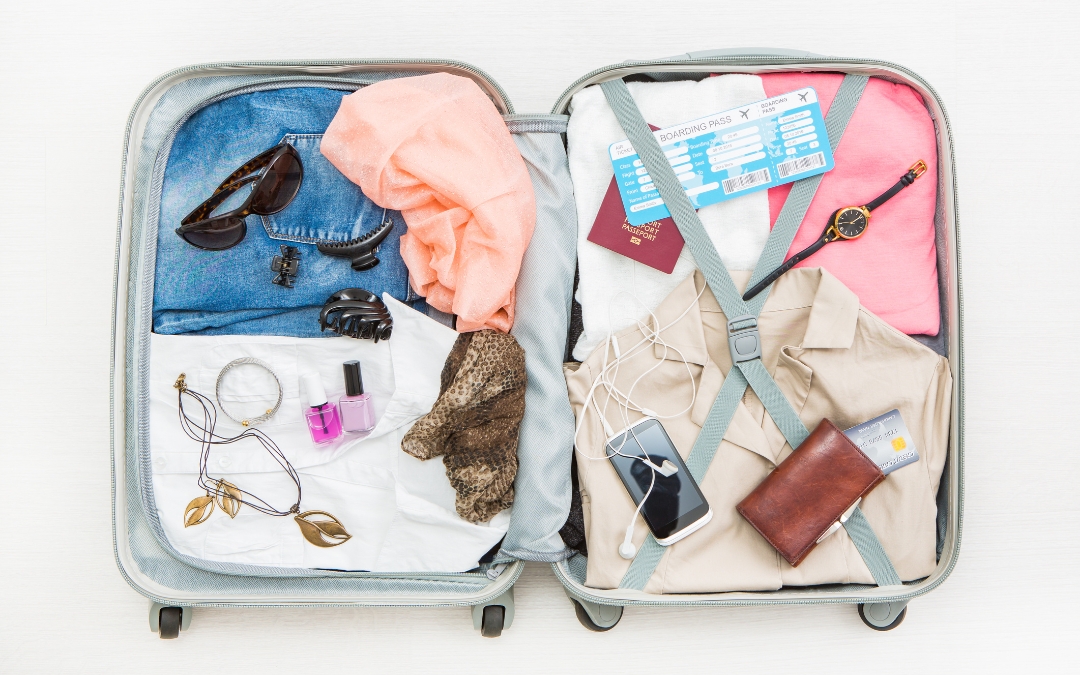
Spring luggage holds light jackets and layers for shifting mild weather.
Summer (June – August)
Vietnam’s summer is hot and humid, with frequent afternoon rain showers. Your focus should be on staying cool, avoiding overheating, and keeping your clothes dry.
What to wear for summer:
- Tops: Breathable t-shirts, tank tops, or short-sleeve shirts made of cotton or linen.
- Bottoms: Shorts, skirts, or light pants.
- Footwear: Sandals or water-resistant shoes. Flip-flops are fine for casual beach visits.
- Beachwear: Swimwear and cover-ups if visiting coastal areas.
- Rain protection: A foldable raincoat or compact umbrella.
Tips:
- Bring light-colored clothing to reflect sunlight and reduce heat.
- Choose moisture-wicking fabrics for comfort in humid weather.
- Consider packing a thin, quick-dry scarf or shawl for visiting temples and other cultural sites where modesty is appreciated.
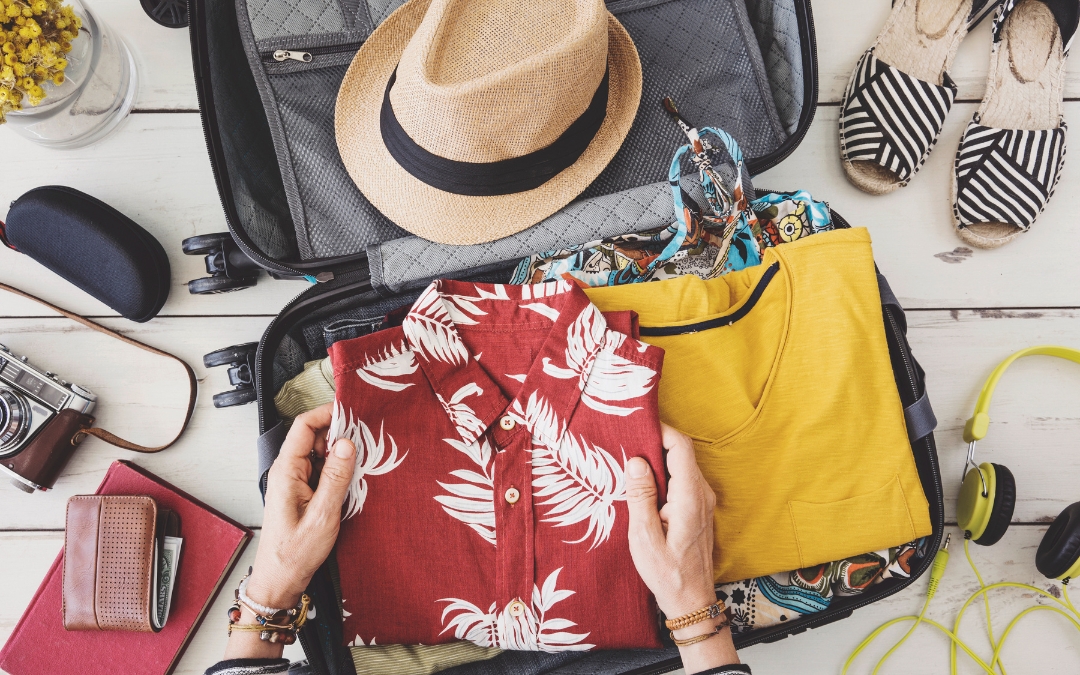
A summer suitcase works best with breathable cotton and rain-ready essentials.
Autumn (September – November)
Autumn offers pleasant weather, but the rainy season can still affect central and southern regions. Temperatures are generally comfortable, with lower humidity than in summer.
What to wear for autumn:
- Tops: Long-sleeve shirts, casual blouses, and lightweight sweaters.
- Bottoms: Comfortable pants or jeans suitable for walking tours.
- Outerwear: Light waterproof jackets or windbreakers for rainy days.
- Footwear: Waterproof or quick-dry shoes. Avoid open-toe sandals if heavy rain is expected.
- Accessories: Hats or caps for sun protection and light scarves for style and warmth.
Tips:
- Layering is still useful in northern cities where mornings can feel cooler.
- Quick-dry fabrics remain essential if you plan on outdoor activities or island hopping.
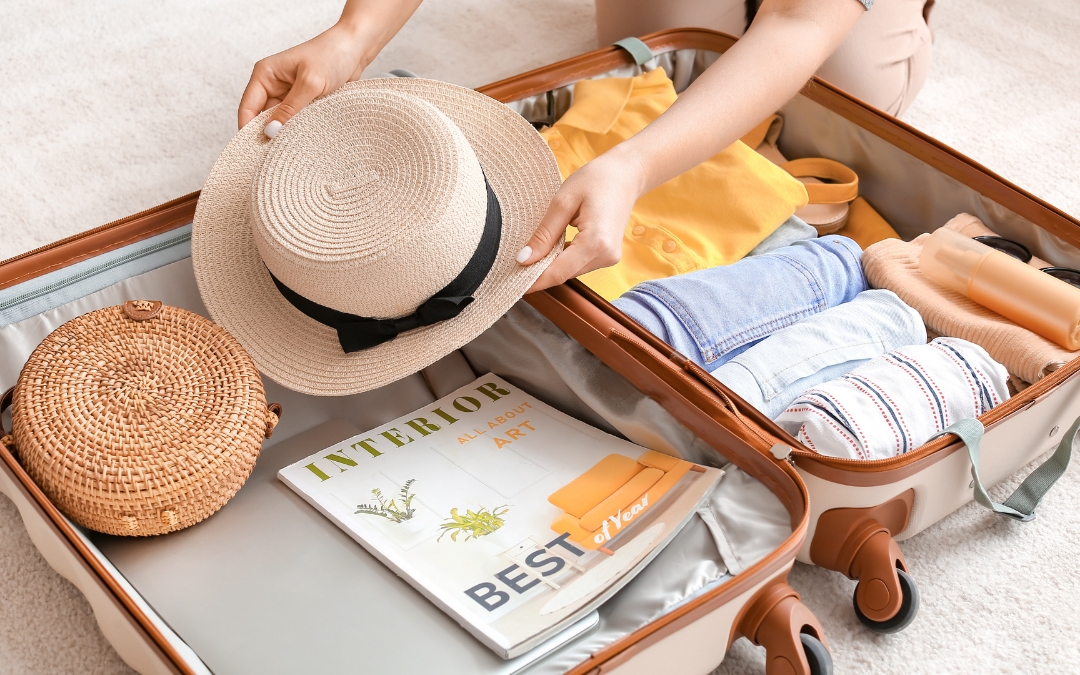
Autumn suitcases include versatile outfits for cool mornings and warm afternoons.
Winter (December – February)
Winter varies greatly by region, so choose clothing based on the areas you plan to visit. Northern Vietnam requires warmer clothing, while the south stays comfortably warm.
What to wear for winter in Vietnam:
- Northern Vietnam: Sweaters, thermal tops, jackets, scarves, and hats. Layers are important for adjusting to both chilly mornings and milder afternoons.
- Central Vietnam: Light to medium jackets, long-sleeve shirts, and trousers.
- Southern Vietnam: Long-sleeve tops or light jackets, paired with breathable pants. Heavy winter clothing is rarely necessary.
- Footwear: Comfortable walking shoes or boots, especially if trekking in northern areas.
Tips:
- Even in winter, lightweight layers are versatile for travel between regions.
- Keep a small umbrella handy for occasional rains in the south and central coast.
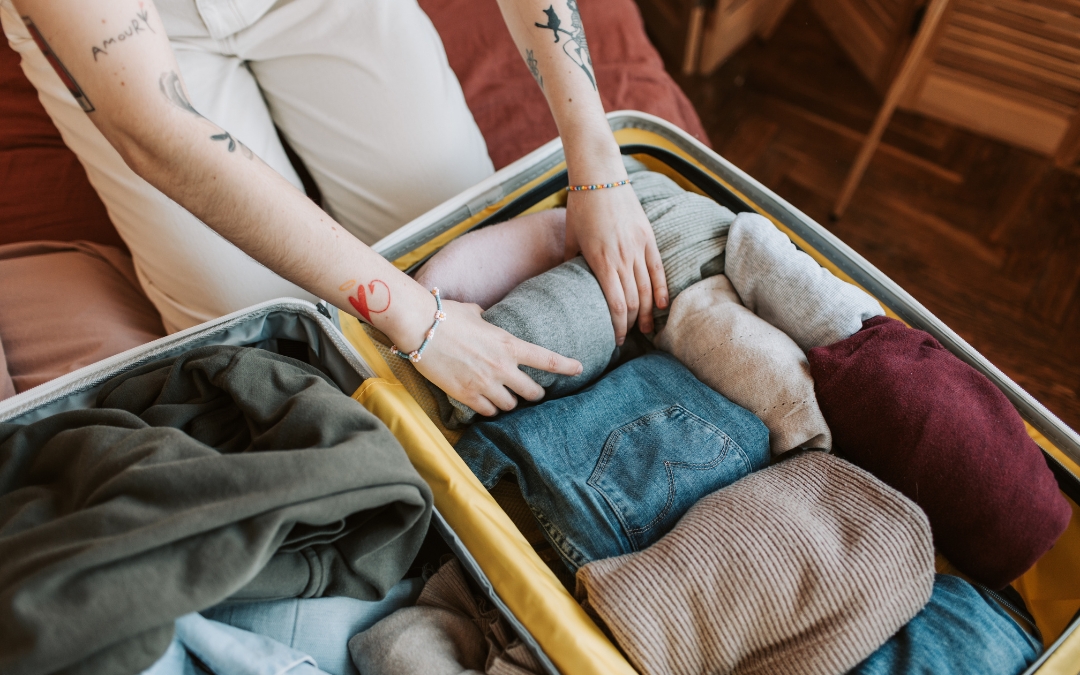
A winter suitcase must carry cozy sweaters to face northern Vietnam’s chill.
>> Read More: 10 Amazing Best Places to Visit in Vietnam in December for Sun-Seekers
Vietnam Packing List: What to Wear by Region
When planning your first trip to Vietnam, knowing what to wear in Vietnam depends heavily on the region you’re visiting. The country’s long and narrow shape means that attire suitable for one area might not be ideal for another. Here’s a detailed guide to help first-time travelers pack smartly and stay comfortable, stylish, and culturally respectful.
Northern Vietnam (Hanoi, Sapa, Halong Bay, Ha Giang)
Northern Vietnam combines urban life with mountain adventures. Here’s what you need:
Urban exploration (Hanoi, Ninh Binh, Halong Bay cruise)
- Lightweight long-sleeve shirts or blouses for sun protection and modesty when visiting temples.
- Comfortable trousers or breathable jeans for walking.
- Sneakers or closed-toe shoes for city streets and uneven pavements.
- Light cardigan or windbreaker for cooler mornings and evenings.
Mountain trekking (Sapa, Ha Giang, Fansipan)
- Layered clothing: T-shirts under fleeces or hoodies for flexibility.
- Waterproof jackets or ponchos in case of rain.
- Hiking pants that are flexible and quick-drying.
- Sturdy hiking boots with good grip; optional gaiters if going off-trail.
- Accessories: scarf, hat, gloves for higher elevations where the temperature drops.
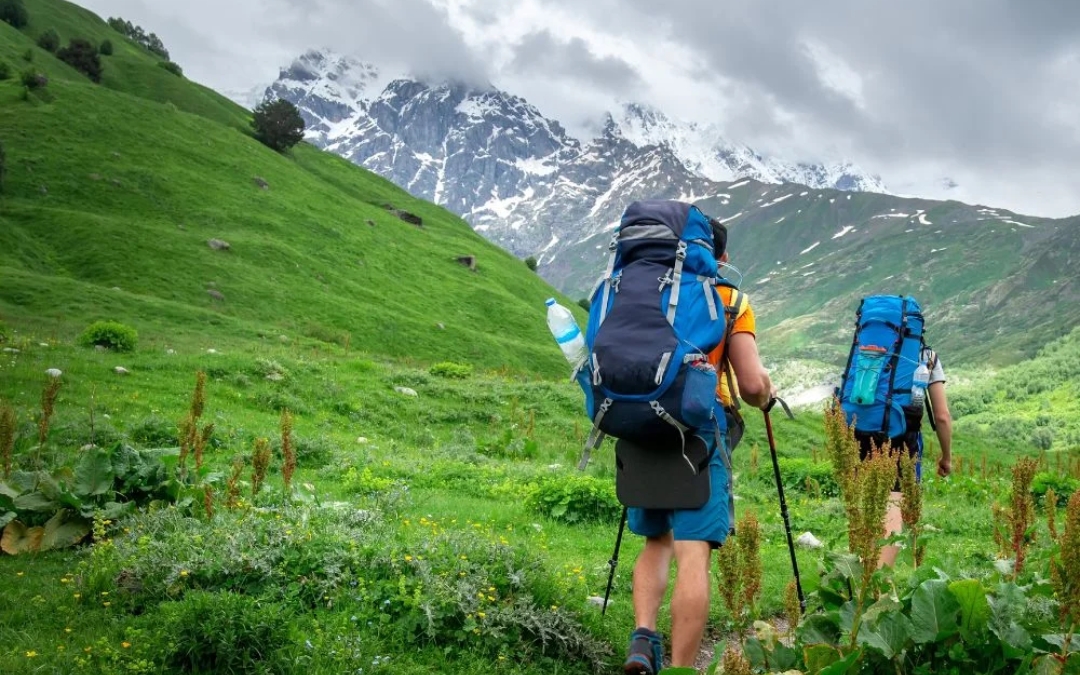
Sapa hikers carry sturdy boots and layers for misty mountain trails.
>> Read More: Hiking In Sapa: Best Time, Planning, Treks and Trails
Central Vietnam (Da Nang, Hoi An, Hue, Nha Trang, Quy Nhon)
Central Vietnam is famous for beaches, historic towns, and coastal weather. Key clothing items:
Beach and resort wear (Da Nang, Nha Trang, Quy Nhon, Phu Yen)
- Swimwear: bikinis, one-piece swimsuits, or trunks.
- Lightweight cover-ups or kaftans for walking to the beach or cafes.
- Sandals, flip-flops, or water shoes for rocky shorelines.
- Sun protection: wide-brim hats, sunglasses, and breathable clothing.
City sightseeing and historic sites (Hoi An, Hue)
- Modest clothing for visiting temples, pagodas, and royal tombs (shoulders and knees covered).
- Lightweight cotton or linen dresses for women; long-sleeve shirts and light trousers for men.
- Comfortable walking shoes or sandals for exploring ancient streets.
Outdoor activities (Marble Mountains, Ba Na Hills, trekking)
- Quick-dry shirts and pants.
- Waterproof jackets or ponchos.
- Hiking shoes or sturdy sneakers.
- Backpack with water-resistant compartments for essentials.
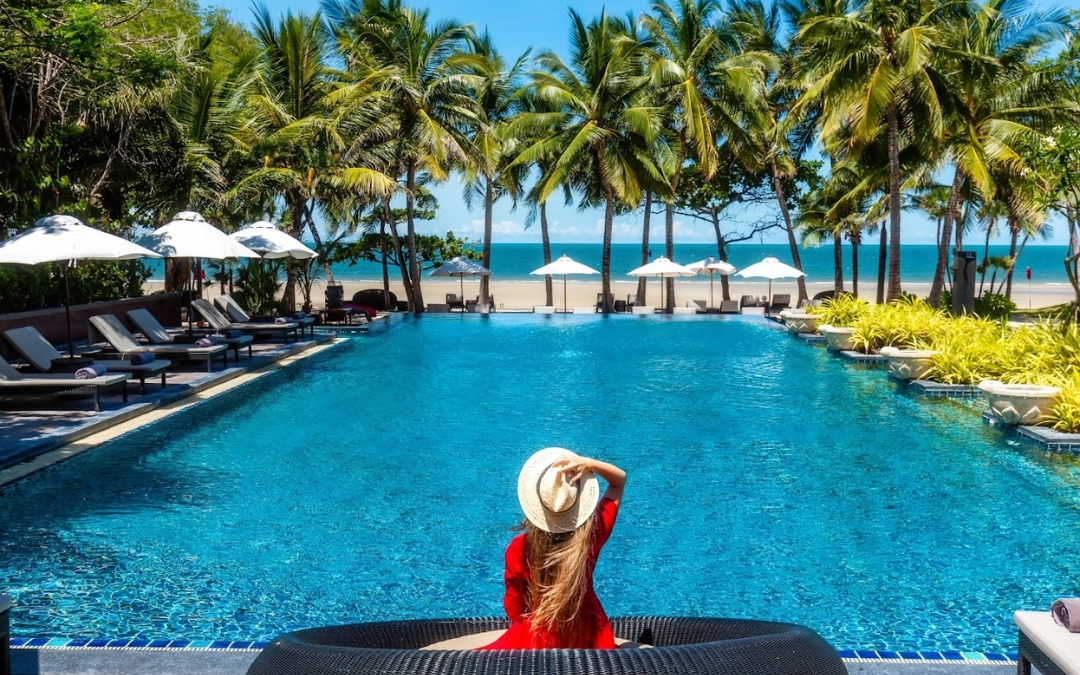
Resort seekers choose relaxed linens and hat for Da Nang beaches.
>> Read More: Top 7 Names That Definitely Should Be On Your Vietnam Beaches List
Southern Vietnam (Ho Chi Minh City, Mekong Delta, Phu Quoc)
The south is tropical, humid, and relaxed, favoring light, breathable clothing.
Urban exploration (Ho Chi Minh City)
- Light, airy tops and trousers or dresses to stay comfortable in heat.
- Sneakers, sandals, or comfortable walking shoes.
- Sun protection: hats, sunglasses, a lightweight scarf for bus or motorbike rides.
- Optional blazer or cardigan for air-conditioned malls, cafes, and offices.
Rivers and delta tours (Mekong Delta, floating markets)
- Lightweight trousers and shirts to protect from sun and mosquitoes.
- Water-resistant sandals or shoes for wet or muddy paths.
- Quick-dry fabrics for boat trips.
Beach destinations (Phu Quoc, Con Dao)
- Swimwear and cover-ups.
- Flip-flops, sandals, water shoes.
- Sun-protective clothing for extended beach activities.
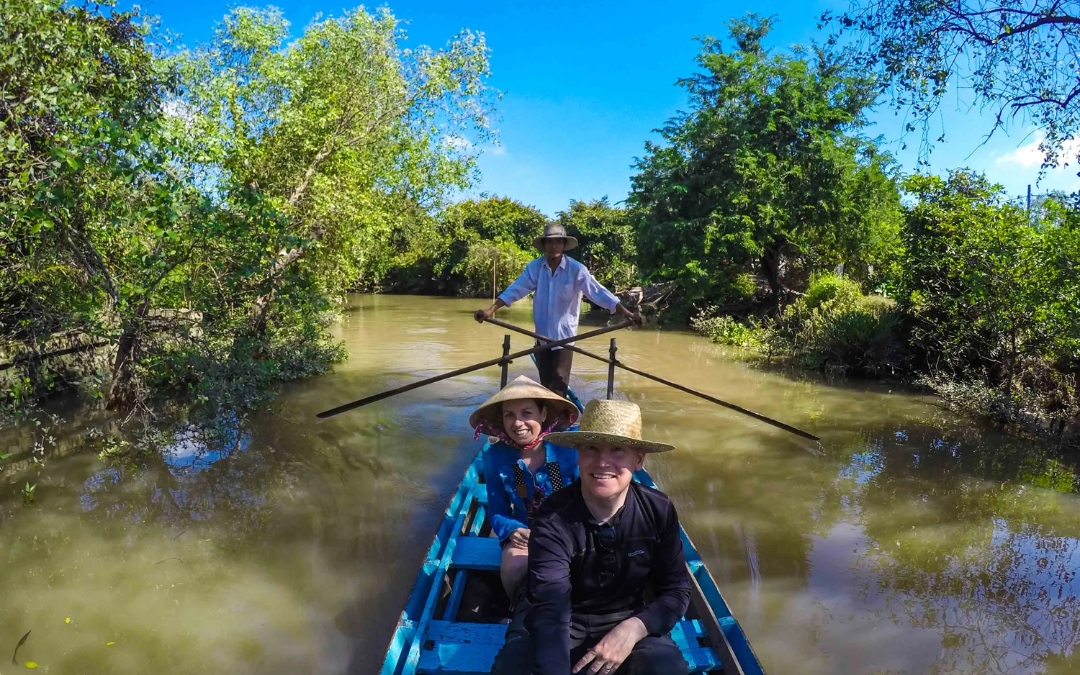
Mekong Delta explorers wear light shirts and hats for river journeys.
>> See Tour: Ho Chi Minh City to Mekong Delta Tour
Understanding Vietnam’s Cultural Sensitivity and Dress Code
Places of Worship
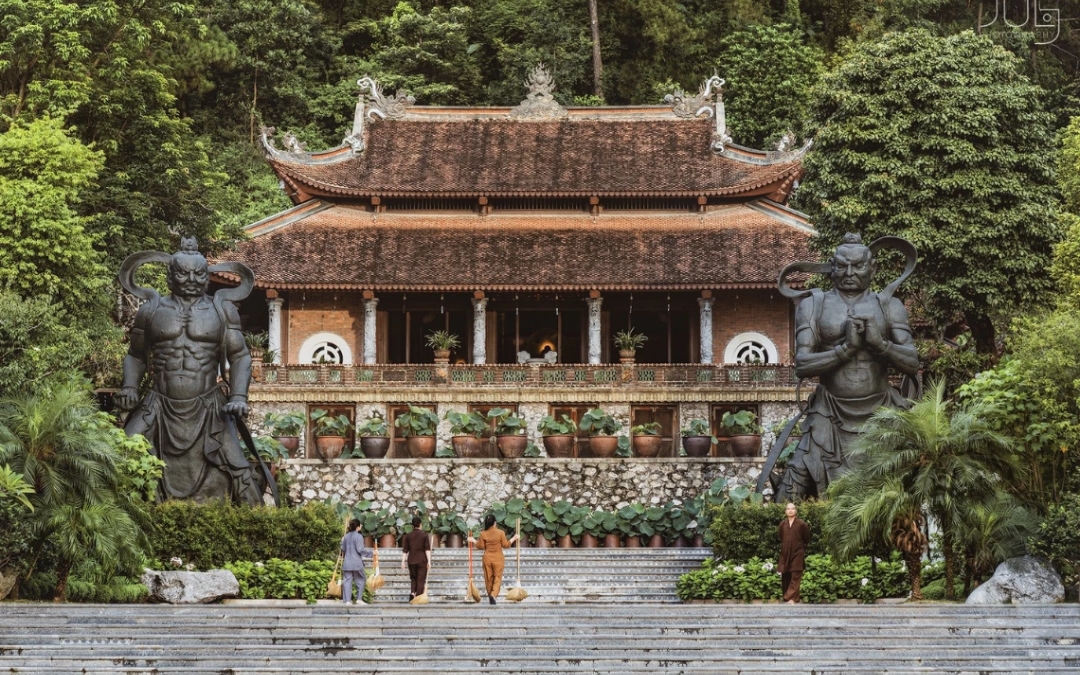
Dress appropriately when visiting sacred sites like Dia Tang Phi Lai Tu Pagoda in Vietnam.
When visiting sacred sites like pagodas, temples, or churches, modesty is key. Generally, covering your shoulders and wearing clothing that extends below the knees is a respectful practice. Notable religious sites like the One Pillar Pagoda in Hanoi or the Cao Dai Temple in Tay Ninh are not just tourist attractions but active centers of worship, and dressing appropriately shows respect for their spiritual significance.
Traditional Events and Festivals
Vietnam is home to numerous festivals like Tết (Vietnamese New Year) and the Mid-Autumn Festival. During such occasions, traditional attire like Ao Dai for women and simple but modest garments for men are appreciated. Understanding and respecting these cultural norms not only enriches your travel experience but also fosters mutual respect between you and the locals.
Everyday Interactions
Even in casual settings, Vietnamese culture leans toward the modest and conservative, particularly in rural areas. While beachwear is acceptable on the shores, a more covered-up approach is advised when venturing into town. Recognizing and adhering to these norms is significant for respectful cultural immersion.
Packing Tips and Tricks
Mastering the Art of Layering
Get ready to conquer any weather Vietnam throws your way by mastering the art of layering! Versatility is the name of the game here, allowing you to switch from misty mountain paths to sunny coastal vistas without breaking a sweat. Imagine easily slipping on or off a lightweight jacket, a thermal layer, or a trendy scarf to suit the moment’s climate. It’s like having a wardrobe for all seasons, all neatly packed in your suitcase!
Selecting Dual-Purpose Items
Now, let’s turn packing into a joyous puzzle where every piece fits perfectly! Consider packing items that serve dual functions. How about a chic scarf that doubles as a head cover for religious sites? Or maybe a versatile wraparound skirt that transitions from casual strolls to formal dinners? These are the ingenious additions that make you feel like a packing genius, saving both space and time as you experience Vietnam’s multifaceted beauty.
The Virtues of Lightweight Luggage
Ah, the freedom of lightweight luggage! It’s an unsung hero in the travel world. Picture yourself gliding effortlessly through bustling markets or hopping onto a last-minute ferry for an island escapade. Choose lightweight yet durable luggage, and prioritize multipurpose essentials. The lighter your load, the more room you’ll have for unexpected souvenirs and spontaneous adventures!
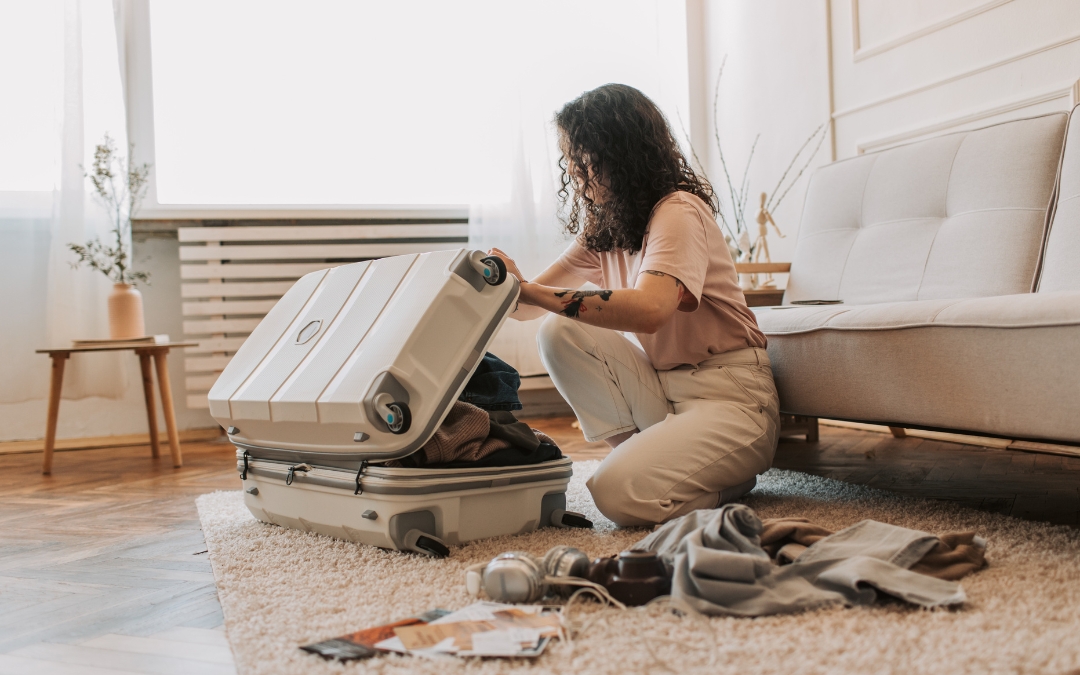
Light luggage frees travelers to explore Vietnam with ease and comfort.
Optimize for Quick-Dry and Easy Care
Vietnam’s tropical climate and sudden showers make quick-dry, easy-care clothing a must. Pack shirts, dresses, or pants that dry fast and resist wrinkles. This way, you can hand-wash items in your hotel or hostel and have them ready by morning, without worrying about ironing or laundry facilities.
Smart Accessories for Every Occasion
Accessories can be tiny heroes of a well-packed suitcase. Wide-brimmed hats, sunglasses, and scarves protect against the sun while adding style to your outfits. A foldable poncho or compact umbrella is indispensable for sudden tropical rain. Small reusable bags or totes are perfect for markets, beaches, or day trips.
Pack Light, Travel Smart
Finally, embrace the magic of a capsule wardrobe. Curate a selection of versatile, mix-and-match items that can take you through city streets, mountain treks, and coastal beaches without weighing you down. Keep a small daypack ready for daily excursions, leaving heavier luggage safely tucked in your hotel. Avoid overpacking “just in case” items—Vietnam has markets, shops, and local stores ready to fill any gap. The lighter you travel, the more spontaneous your adventures can be, whether that’s a last-minute boat ride in Ha Long Bay or a street food tour in Ho Chi Minh City.
>> See Tour: The Very Best of Vietnam
Conclusion
You’ve done your research on “What to wear in Vietnam” and packed intelligently. Your clothing selections aren’t simply for keeping cool or warm but also a nod to Vietnam’s intricate culture. With luggage full of versatile and appropriate attire, you’re not only prepared for the weather but also ready to immerse yourself in the local lifestyle. So go ahead and close your suitcase and take a deep breath. An enriching, respectful, and completely phenomenal Vietnamese holiday is just a flight away.
With Asia Pioneer Travel, we’ll not only craft your dream itinerary but also guide you in choosing the right outfits to honor the climate, traditions, and local lifestyle. Start your adventure with confidence and authenticity.
